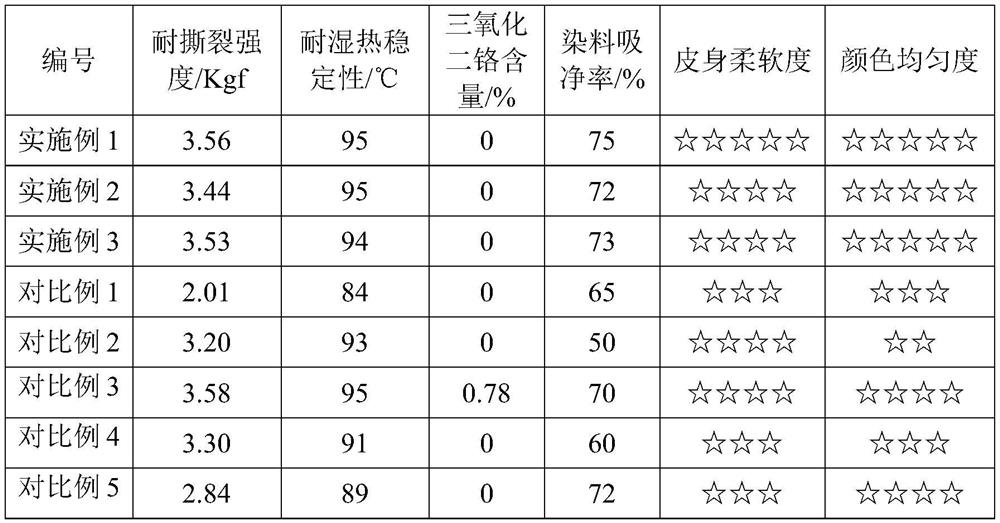Retanning process of environmentally friendly vegetable tanned elastic leather products
A kind of elastic and leather technology, which is applied in the field of retanning process of environmentally friendly vegetable tanned elastic leather products, can solve the problems that chromium-containing waste cannot be effectively treated, the tear resistance of leather is average, and the skin’s hygienic performance is not good. Achieving significant treatment effects, improving the utilization rate of chemical materials, and shortening the production cycle
- Summary
- Abstract
- Description
- Claims
- Application Information
AI Technical Summary
Problems solved by technology
Method used
Image
Examples
Embodiment 1
[0078] A process for retanning sheet skin of an environmentally friendly vegetable tanned elastic leather product, comprising the following steps:
[0079] 1) Backwater the elastic leather skin, and the materials selected for backwater include the following components based on the weight of the leather: 200% water, temperature 40°C, 0.2% acetic acid, 1% rehumidification aid BPR, 0.5 % of synthetic fatliquoring agent NP-2; add the materials selected for the return water into the drum in turn, and then quickly cast the skins after turning evenly, turn for 60 minutes, and turn the drum for 5 minutes per hour for 4 hours overnight, drain, and wash with cold water ;
[0080] 2) Retanning: Add the following components in the drum according to the weight of the skin: 100% water, temperature 40°C, 1% tear-resistant fatliquor NZ, 2% sulfonated fatliquor TIS, 0.2% emulsifier SAF, rotate for 30 minutes, carry out pre-fatliquoring treatment to the skin after returning to water, then add ...
Embodiment 2
[0091] 1) Backwater the elastic leather skin, and the materials selected for backwater include the following components based on the weight of the leather: 200% water, temperature 40°C, 0.2% acetic acid, 1% rehumidification aid BPR, 0.5 % of synthetic fatliquoring agent NP-2; add the materials selected for the return water into the drum in turn, and then quickly cast the skins after turning evenly, turn for 60 minutes, and turn the drum for 5 minutes per hour for 4 hours overnight, drain, and wash with cold water ;
[0092]2) Retanning: Add the following components in the drum according to the weight of the skin: 100% water, temperature 40°C, 1% universal fatliquoring agent WWL, 2% sulfonated fatliquoring agent TIS, 0.2% emulsifier ML-N, rotated for 30 minutes, pre-fatted the skin after returning to water, then added 0.8% formic acid, rotated for 20 minutes, added 6% environmental protection tanning agent TWE, rotated for 60 minutes, added 1 % sodium formate, rotate for 90 mi...
Embodiment 3
[0103] 1) The elastic leather skin is returned to water, and the materials selected for the return water include the following components based on the weight of the leather: 200% water, temperature 40°C, 0.2% oxalic acid, 1% rehumidification aid VLC-3 , 0.5% synthetic fatliquoring agent NP-2; add the materials selected for the return water into the drum in turn, and quickly cast the skin after mixing evenly, and turn for 60 minutes. wash once;
[0104] 2) Retanning: Add the following components in the drum according to the weight of the skin: 100% water, temperature 40°C, 1% universal fatliquoring agent WWL, 2% sulfited fatliquoring agent CFS, 0.2% % emulsifier ML-N, rotate for 30 minutes, pre-fat the skin after returning to water, then add 0.8% formic acid, rotate for 20 minutes, add 6% environmental protection tanning agent TWE, rotate for 60 minutes, add sodium formate 1%, rotate for 90 minutes, adjust the pH value of the bath to 3.6-3.8, rotate the drum for 5 minutes per ...
PUM
| Property | Measurement | Unit |
|---|---|---|
| thickness | aaaaa | aaaaa |
Abstract
Description
Claims
Application Information
 Login to View More
Login to View More - R&D
- Intellectual Property
- Life Sciences
- Materials
- Tech Scout
- Unparalleled Data Quality
- Higher Quality Content
- 60% Fewer Hallucinations
Browse by: Latest US Patents, China's latest patents, Technical Efficacy Thesaurus, Application Domain, Technology Topic, Popular Technical Reports.
© 2025 PatSnap. All rights reserved.Legal|Privacy policy|Modern Slavery Act Transparency Statement|Sitemap|About US| Contact US: help@patsnap.com

